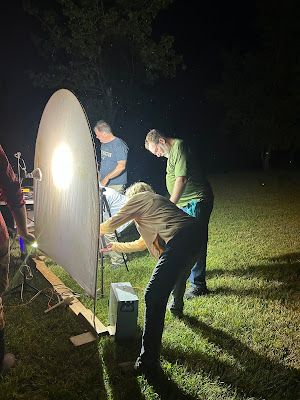We’ve all seen evidence of this: fishing hotspots peppered with various trash, not the least of which is abandoned fishing line. It’s not just Ohio fishermen that discard monofilament line. Worldwide, it’s estimated that up to a third of all fishing lines are pitched.
Cast-off fishing line is known as “ghost gear” and is among the deadliest forms of human debris to wildlife.
On Tuesday, July 9, photographers Shauna Weyrauch and Dutch Gordon ventured to the upper end of Alum Creek Reservoir to photograph the nesting ospreys found there. Arriving shortly after dawn, they prepared for what should have been a fun morning of photographing the “fish hawks” at their nest.
A good vantage point for osprey observation is also a popular area for bank fishermen, replete with the usual cast-off tackle. About the first thing that Dutch and Shauna noticed upon arrival was a barred owl dangling from a tree, one of its wings ensnared in fishing line.
Osprey photography forgotten, they quickly set about with rescue attempts. The difficulty of this was compounded by the fact that the owl was suspended about 6 feet above the water of the reservoir, unreachable from shore.
Fortunately, the main offices of Preservation Parks of Delaware County are just two minutes down the road. Another photographer that had arrived on scene, Dennis Roush, drove over to find some park employees preparing for the day.
Preservation Parks employees Lauren Richards, Zoe Swanson, Tyler Swartzlander and Adam Wilson dropped everything and rushed to the site. Richards and Swanson donned hip waders, entered the water and soon had the owl in safe hands.
They promptly took it to the Ohio Wildlife Center (OWC) near the Columbus Zoo, the largest wildlife rehabilitation facility in the state, as Preservation Parks is not equipped to take in and deal with injured wildlife.
Unfortunately, the owl, due to its struggles to escape the fishing line, had suffered a complete luxation (dislocation) of its left wing. There’s no recovery from that and the owl had to be euthanized.
Kudos to all involved in the rescue. They dropped everything and did their darndest for the owl. But deadly fishing line had claimed another victim. And that owl is by no means the only casualty of ghost gear.
David Donahue of the OWC informed me that so far this year, 22 victims of cast-off line have been brought to the center, 12 of which died. Some of the victims included a belted kingfisher, a great blue heron and a snapping turtle.
In all, the OWC received 117 victims of fishing line over the last decade, representing 23 species. Fifty-four of those patients could not be saved. Canada geese and mallards were the most common, and turtles of six species represented 27 individuals.
Particularly sad losses included another barred owl, an eastern screech owl, a mudpuppy (large salamander), a red-shouldered and red-tailed hawk, a redhead duck and a pileated woodpecker.
The OWC patients represent the tip of the iceberg regarding fishing-line mortality. All of the other rehab facilities would probably report similar data, and the vast majority of victims never receive treatment and are not reported.
Cast-off line typically occurs in high-use wildlife habitat: the interface between water and land. The problems caused by fishing-line litter are well documented and indisputable. The solution is simple, and completely in the hands of the fishermen that have caused the problem. Dispose of your fishing line properly, not in the wild. Scores of creatures would be grateful.
Naturalist Jim McCormac writes a column for The Dispatch on the first and third Sundays of the month. He also writes about nature at jim mccormac.blogspot.com.

%20copy.jpg)
%20copy.jpg)
.CR3.jpg)
.jpg)
%20copy.jpg)
%20copy.jpg)

%20copy.jpg)
%20copy.jpg)
%20copy.jpg)
 This is a Rosy Maple Moth peering into the camera, and side view in the following photo so you can better see what one looks like. RMM's are one of the most common silkmoths and easily identified.
This is a Rosy Maple Moth peering into the camera, and side view in the following photo so you can better see what one looks like. RMM's are one of the most common silkmoths and easily identified.%20copy.jpg)

%20copy.jpg)
%20copy.jpg)
%20copy.jpg)
%20copy.jpg)
%20copy.jpg)


%20copy.jpg)

%20copy.jpg)
%20copy.jpg)